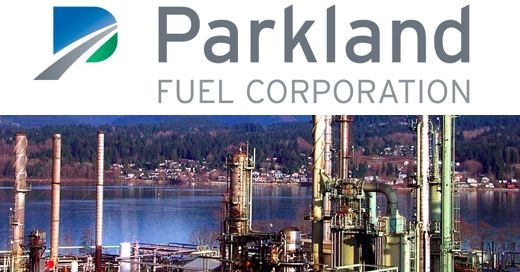Adjusted EBITDA1,2 of approximately $2.5 billion in 2028, with anticipated upside to $3 billion
Available cash flow per share1,2 to double by 2028
Reduce Leverage Ratio1,2 to low end of 2 to 3 times target range by the end of 2025
CALGARY, AB, Nov. 14, 2023 /PRNewswire-HISPANIC PR WIRE/ — Parkland Corporation (“Parkland”, “we”, the “Company”, or “our”) (TSX:PKI), will host its 2023 Investor Day today where its executive team will outline the Company’s continued growth plans, targets, and capital allocation strategy for the next five years.

“Since our 2021 Investor Day, we have continued to build and invest in our growth platform,” said Bob Espey, President and Chief Executive Officer. “This year, we saw the strength of our business model as we delivered strong organic growth and synergy capture, enabling us to increase Adjusted EBITDA Guidance, exceed our deleveraging goals, and accelerate our $2 billion ambition to 2024, a year ahead of schedule.”
“The success of Parkland’s strategy is due to our industry leading team, which is focused on safe and disciplined execution,” added Espey. “Our business is growing, and we are committed to meeting the evolving needs of our customers. We are reinforcing our financial foundation, delivering substantial cash flow and, through disciplined capital allocation, we will optimize returns for our shareholders.”
During today’s Investor Day, Parkland’s executive team will discuss:
Customer Advantage
Parkland’s customer centric strategy demonstrates our commitment to becoming the number one choice for energy and convenience, for our Retail and Commercial customers, in the markets we serve.
Our JOURNIE™ loyalty platform is a foundation of this strategy as it expands its suite of partners and geographic reach. It will continue to unify our brands, delivering personalized customer offers, while incentivizing and rewarding customer loyalty across our retail fuel and EV charging locations, ON the RUN convenience stores, and food brands.
In addition to its retail footprint, Parkland serves a diverse range of Commercial customers in each of its markets. Our extensive proprietary infrastructure and dedicated team safely and reliably deliver products to our customers that meet their energy needs of today, and their evolving low carbon needs of tomorrow.
Supply Advantage
Parkland’s proven supply expertise underpins its strategy. By delivering approximately 28 billion litres of fuel annually, the Company’s scale, unique logistics assets, and capabilities provide purchasing power and optionality that enable us to achieve the lowest cost to serve. Our supply optimization allows us to create tremendous competitive advantage and unlock significant value in the markets we operate.
Disciplined Capital Allocation
We anticipate $6 billion in cumulative Available cash flow from 2024 to 2028. We are positioned to deliver sustainable growth, enhance shareholder returns and strengthen our balance sheet.
The Company’s capital allocation program will direct approximately $1.5 billion (25 percent) to dividends and share buybacks, and $1.5 billion (25 percent) to organic growth initiatives that reinforce our market position.
With the remaining $3 billion (50 percent) of anticipated capital, we will prioritize reducing our Leverage Ratio to the low end of our two to three times target range by the end of 2025. Beyond that and looking forward through 2028, we expect capital will be strategically allocated toward opportunities that generate the greatest shareholder returns, including additional share buybacks and inorganic growth opportunities. This framework underscores Parkland’s dedication to financial discipline and strategic agility, with the aim of delivering long-term value for our shareholders.
Parkland remains focused on executing its strategy, capturing synergies, lowering costs, and delivering organic growth. During Investor Day, Parkland will outline the Company’s 2024 Guidance and 2028 Ambitions.
2024 Guidance2
- Adjusted EBITDA of $2 billion +/- $50 million
- Capital expenditures1 of between $475 million to $525 million.
- Available cash flow per share of $5.00.
- ROIC1 of more than 11 percent.
2028 Ambitions
- Available cash flow of $8.50 per share, doubling from $4.25 per share in 20233.
- Adjusted EBITDA of $2.5 billion, driven by organic growth, synergy capture and cost efficiencies. We see potential to generate up to $3 billion of Adjusted EBITDA in 2028, reflecting disciplined inorganic growth opportunities as outlined in our capital allocation framework.
| __________ | |
| 1 | Specified Financial Measure. See “Specified Financial Measure” section of this news release. |
| 2 | See “Forward Looking Statements” section of this news release for assumptions underlying Parkland’s 2024 Guidance and 2028 Ambitions. |
| 3 | Trailing-twelve-months (“TTM”) Q3 2023. |
Investor Day Webcast Details
The Investor Day presentation will be webcast, with video, beginning at 9 am Eastern Time (7 am Mountain Time) on November 14, 2023. For analysts and investors who have already registered to attend in person, or remotely, we look forward to your participation.
The presentation will be available live at https://investorday.parklandevents.ca/ and will be available for replay at www.parkland.ca/investors/presentations-webcasts following the conclusion of today’s event.
About Parkland Corporation
Parkland is an international fuel distributor, marketer, and convenience retailer with operations in 25 countries across the Americas. We serve over one million customers each day. Our vast retail network meets the fuel and convenience needs of everyday consumers. Our commercial operations provides businesses with industrial fuels so that they can better serve their customers. With approximately 4,000 retail and commercial locations across Canada, the United States and the Caribbean region, we have developed supply, distribution and trading capabilities to accelerate growth and business performance.
In addition to meeting our customers’ needs for essential fuels, we provide a range of choices to help them lower their environmental impact. These include carbon and renewables trading, solar power, renewables manufacturing and ultra-fast EV charging. Parkland’s proven business model is centered around organic growth, our supply advantage, and is driven by scale, our integrated refinery and supply infrastructure, and focus on acquiring prudently and integrating successfully.
Our strategy is focused on developing our existing business in resilient markets, growing our food, convenience and renewable energy businesses and helping customers to decarbonize. Our business is underpinned by our people, our values of safety, integrity, community and respect, which are deeply embedded across our organization.
Forward-Looking Statements
Certain statements contained herein constitute forward-looking information and statements (collectively, “forward-looking statements”). When used the words “expect”, “will”, “could”, “would”, “believe”, “continue”, “pursue” and similar expressions are intended to identify forward-looking statements. In particular, this news release contains forward-looking statements with respect to, among other things: business strategies, objectives and initiatives; expected market trends; Parkland’s 2024 Adjusted EBITDA Guidance, 2024 Capital Expenditure Guidance, 2024 Available cash flow per share Guidance, 2024 ROIC Guidance; Parkland’s 2028 Available cash flow per share Ambition, 2028 Adjusted EBITDA Ambition, and anticipated potential to generate up to $3 billion of Adjusted EBITDA in 2028; Parkland’s expectation to generate $6 billion in cumulative Available cash flow between 2024 and 2028, and expected uses for such under Parkland’s capital allocation program, including direction of approximately $1.5 billion (25 percent) to dividends and share buybacks, $1.5 billion (25 percent) to organic growth initiatives, and $3 billion (50 percent) to reduction of Parkland’s Leverage Ratio to low 2x by 2025, and subsequently to additional share buybacks and inorganic growth opportunities.
These statements involve known and unknown risks, uncertainties and other factors that may cause actual results or events to differ materially from those anticipated in such forward-looking statements. No assurance can be given that these expectations will prove to be correct and such forward-looking statements included in this news release should not be unduly relied upon. These forward-looking statements speak only as of the date of this news release. Parkland does not undertake any obligation to publicly update or revise any forward-looking statements except as required by securities law. Actual results could differ materially from those anticipated in these forward-looking statements as a result of numerous risks and uncertainties including, but not limited to, general economic, market and business conditions; micro and macroeconomic trends and conditions, including increases in interest rates, inflation and commodity prices; customer preferences and trends; Parkland’s competitive advantages, including key products and brands, proprietary infrastructure and supply advantage, and ability to maintain such advantages; Parkland’s ability to retain key employees; Parkland’s ability to execute its business objectives, projects and strategies, including the completion, financing and timing thereof, realizing the benefits therefrom and meeting our targets and commitments relating thereto; Parkland’s ability to identify buyers and complete divestments, if any, on terms reasonable to Parkland and in a timely manner; Parkland’s ability to execute on accretive organic initiatives and grow to meet its 2024 Guidance and 2028 Ambitions and expected outcomes; Parkland’s management systems and programs and risk management strategy; Parkland’s ability to pay future dividends and complete share buybacks; competitive environment of our industry; retail pricing, margins and refining crack spreads; availability and pricing of petroleum product supply; volatility of crude oil and refined product prices; ability of suppliers to meet commitments; actions by governmental authorities and other regulators including but not limited to increases in taxes or restricted access to markets; environmental impact; changes in environmental and regulatory laws, including the ability to obtain or maintain required permits; expectations with respect to debt repayment and non-cash working capital; and other factors, many of which are beyond the control of Parkland. In addition, the 2024 Adjusted EBITDA Guidance reflects continued integration of acquired businesses and synergy capture, and organic growth initiatives, and the key material assumptions include: an increase in Retail and Commercial Fuel and petroleum product adjusted gross margin and Food, convenience and other adjusted gross margin of approximately 5 percent as compared to the year ending December 31, 2023; the realization of $100 million of MG&A cost efficiencies by 2024; and Refining adjusted gross margin of approximately $37 to $38 per barrel and average Burnaby Refinery utilization of 85 percent to 90 percent based on the Burnaby Refinery’s crude processing capacity of 55,000 barrels per day. 2024 Available cash flow per share Guidance and 2024 ROIC Guidance assumes invested capital grows at a slower pace than Net Operating Profit After Tax through 2024. 2024 Capital Expenditure Guidance is mainly driven by increased Adjusted EBITDA and assumes no material changes to underlying operations and no planned major turnaround at the Burnaby Refinery. 2028 Ambitions reflect continued organic growth from growth capital expenditure attributable to Parkland in line with historical returns, synergy capture from previously completed acquisitions, identified cost efficiencies, potential acquisitions (not identified, but reflective of expected market returns and similar to expected returns from organic growth initiatives), disciplined inorganic growth opportunities, major planned Burnaby Refinery turnarounds in 2025 and 2028, interest rates on long term bank debt and corporate bonds as set out in the Interim Consolidated Financial Statements for the three and nine months ended September 30, 2023, with any maturing debts set to retire in the interim periods extended at current prevailing market rates, income taxes at expected corporate income tax rates, including the impact of Pilar II legislation, and the key material assumptions and risks include: ongoing operations without any material economic, legal, environmental or income tax changes and per share metrics impacted by share buybacks, with the assumption that the outstanding common shares do not change materially. See also the risks and uncertainties described in “Cautionary Statement Regarding Forward-Looking Information” and “Risk Factors” included in Parkland’s most recently filed Annual Information Form, and in “Forward-Looking Information” and “Risk Factors” in the Management’s Discussion and Analysis dated November 1, 2023, for the three and nine months ended September 30, 2023 (“Q3 2023 MD&A”), each as filed on the System for Electronic Data Analysis and Retrieval + (“SEDAR+”) and available on the Parkland website at www.parkland.ca.
Supplementary Financial Measures
This news release refers to certain non-GAAP financial measures and ratios and supplementary financial measures (collectively “specified financial measures”). Available cash flow and Available cash flow Guidance are non-GAAP measures; Available cash flow per share Guidance, Available cash flow per share Ambition, and ROIC Guidance are non-GAAP financial ratios; and Adjusted EBITDA Guidance, Adjusted EBITDA Ambition, Leverage Ratio Guidance, and Capital Expenditure Guidance are supplementary financial measures, all of which do not have standardized meanings prescribed by International Financial Reporting Standards (“IFRS”) and may not be comparable to similar financial measures used by other issuers who may calculate these measures differently. See below for further information on these specified financial measures. See Section 16 of the Q3 2023 MD&A for a discussion of Adjusted EBITDA Guidance, Leverage Ratio Guidance, and Capital Expenditure Guidance, including an explanation of their composition, and, where applicable, their reconciliations to the nearest IFRS measures, which is hereby incorporated by reference into this presentation. Investors are cautioned that these measures should not be construed as an alternative to net earnings or other directly comparable financial measures determined in accordance with IFRS as an indication of Parkland’s performance.
Available cash flow is a non-GAAP financial measure and Available cash flow per share is a non-GAAP financial ratio. The most directly comparable financial measure for Available cash flow and Available cash flow per share is cash generated from (used in) operating activities. These measures represent Parkland’s ability to generate cash flows for distribution to shareholders and investment in the growth of the business. Available cash flow is calculated as cash generated from (used in) operating activities adjusted for items such as (i) net change in non-cash working capital, (ii) change in other assets and other liabilities, (iii) change in risk management and other, (iv) maintenance capital expenditures, (v) dividends received from investments in associates and joint ventures, (vi) interest on leases and long-term debt, and (vii) principal payments on leases. Available cash flow per share is calculated as Available cash flow divided by the weighted average number of outstanding common shares. Available cash flow Guidance and Available cash flow per share Guidance are the forward-looking metrics of these historical measures for 2024 and Available cash flow per share Ambition is the forward-looking metric of the historical measure for 2028. Available cash flow per share replaced cash generated from (used in) operating activities per share in Parkland’s 2024 Guidance. See following table for a calculation of historical Available cash flow and Available cash flow per share and a reconciliation to cash generated from (used in) operating activities.
| 2021 | 2022 | TTM Q3 2023 | |
| Cash generated from (used in) operating activities | $ 904 | $ 1,326 | $ 1,992 |
| Exclude: Adjusted EBITDA to NCI | $ (92) | $ (64) | $ — |
| Subtotal | $ 812 | $ 1,262 | $ 1,992 |
| Reverse: change in other liabilities and assets | $ (11) | $ (3) | $ (16) |
| Reverse: change in risk management and other | $ 15 | $ 5 | $ (87) |
| Reverse: net change in working capital | $ 342 | $ 139 | $ (286) |
| Include: maintenance capital expenditures | $ (217) | $ (253) | $ (310) |
| Include: dividends from investments | $ 14 | $ 17 | $ 22 |
| Include: interest on leases and debt | $ (223) | $ (295) | $ (350) |
| Exclude: interest on leases and debt from NCI | $ 4 | $ 2 | $ — |
| Include: lease principal | $ (142) | $ (177) | $ (216) |
| Exclude: lease principal from NCI | $ 18 | $ 11 | $ — |
| Available cash flow | $ 612 | $ 708 | $ 749 |
| Weighted average shares outstanding (basic) | 151 | 160 | 176 |
| Available cash flow per share | $ 4.05 | $ 4.43 | $ 4.25 |
Return on Invested Capital (“ROIC”) is a non-GAAP ratio and is composed of Net Operating Profit After Tax (“NOPAT”) and Invested Capital. NOPAT describes the profitability of Parkland’s base operations, excluding the impact of leverage and expenses not directly related to operations. Invested capital is a measure of the total amount of capital deployed by Parkland that includes debt and equity, net of cash and cash equivalents (restricted and unrestricted). ROIC is used by management to assess the Company’s efficiency in allocating capital. The most directly comparable financial measure to ROIC is net earnings. ROIC Guidance is the forward-looking metric of this historical measure for 2024. 2024 NOPAT is assumed to grow in proportion to Adjusted EBITDA. The ROIC Guidance of 11 percent+ assumes Invested Capital increases at a slower pace than NOPAT through 2024. The ROIC calculated here differs from the absolute ROIC disclosed in the Management Information Circular. See following table for a calculation of historical ROIC for 2021 and 2022, the calculation of NOPAT and the reconciliation to net earnings and the calculation of Invested Capital.
| ROIC | 2021 | 2022 | |
| In C$ Millions Unless Otherwise Noted | |||
| Net Earnings | $ 126 | $ 346 | |
| Income Tax Expense | $ 36 | $ 70 | |
| Acquisition, Integration and Other | $ 52 | $ 117 | |
| Depreciation | $ 616 | $ 743 | |
| Finance Costs | $ 323 | $ 331 | |
| Unrealized Foreign Exchange | $ (7) | $ (8) | |
| Unrealized Risk Management | $ 10 | $ 39 | |
| Other (Gains) and Losses | $ 190 | $ 23 | |
| Other Adjusting Items | $ 12 | $ 26 | |
| Adjusted EBITDA, Including NCI | $ 1,358 | $ 1,687 | |
| Depreciation | $ (616) | $ (743) | |
| Adjusted EBIT | $ 742 | $ 944 | |
| Average Effective Tax Rate | 23 % | 23 % | |
| Taxes | $ (171) | $ (217) | |
| Net Operating Profit After Tax | $ 571 | $ 727 | |
| Average Invested Capital | $ 7,300 | $ 8,722 | |
| ROIC | 7.8 % | 8.3 % | |
| Invested Capital | 2020 | 2021 | 2022 |
| Long-Term Debt – Current Portion | $ 114 | $ 124 | $ 173 |
| Long-Term Debt | $ 3,861 | $ 5,432 | $ 6,799 |
| Shareholders’ Equity | $ 2,266 | $ 2,332 | $ 3,037 |
| Sol Put Option | $ 503 | $ 589 | $ — |
| Less: Cash and Cash Equivalents | $ (296) | $ (326) | $ (716) |
| Total | $ 6,448 | $ 8,151 | $ 9,293 |







